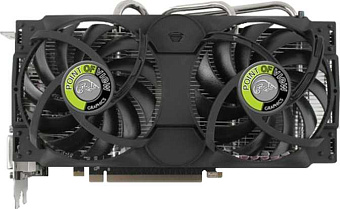 Point of View GeForce GTX 660 Ti 3GB
Point of View GeForce GTX 660 Ti 3GB
 Point of View GeForce GTX 660 Ti 3GB
Point of View GeForce GTX 660 Ti 3GB
Comparision Point of View GeForce GTX 660 Ti 3GB vs Point of View GeForce GTX 660 Ti 3GB
Grade
Top specs and features
- Passmark score
- 3DMark Cloud Gate GPU benchmark score
- 3DMark Fire Strike Score
- 3DMark Fire Strike Graphics test score
- 3DMark 11 Performance GPU benchmark score
Passmark score
3DMark Cloud Gate GPU benchmark score
3DMark Fire Strike Score
3DMark Fire Strike Graphics test score
3DMark 11 Performance GPU benchmark score
Description
The Point of View GeForce GTX 660 Ti 3GB video card is based on the Kepler architecture. Point of View GeForce GTX 660 Ti 3GB on the Kepler architecture. The first has There is no data million transistors. The second is 3540 million. Point of View GeForce GTX 660 Ti 3GB has a transistor size of There is no data nm versus 28.
The base clock speed of the first video card is There is no data MHz versus 915 MHz for the second.
Let's move on to memory. Point of View GeForce GTX 660 Ti 3GB has There is no data GB. Point of View GeForce GTX 660 Ti 3GB has There is no data GB installed. The bandwidth of the first video card is There is no data Gb/s versus 144 Gb/s of the second.
FLOPS of Point of View GeForce GTX 660 Ti 3GB is There is no data. At Point of View GeForce GTX 660 Ti 3GB 2.38.
Goes to tests in benchmarks. In the Passmark benchmark, Point of View GeForce GTX 660 Ti 3GB scored 4375 points. And here is the second card 4302 points. In 3DMark, the first model scored 5440 points. Second 5350 points.
In terms of interfaces. The first video card is connected using PCIe 3.0 x16. The second is PCIe 3.0 x16. Video card Point of View GeForce GTX 660 Ti 3GB has Directx version There is no data. Video card Point of View GeForce GTX 660 Ti 3GB -- Directx version - 11.
Regarding cooling, Point of View GeForce GTX 660 Ti 3GB has There is no dataW heat dissipation requirements versus 150W for Point of View GeForce GTX 660 Ti 3GB.
Why Point of View GeForce GTX 660 Ti 3GB is better than Point of View GeForce GTX 660 Ti 3GB
- Passmark score 4375 против 4302 , more on 2%
- 3DMark Cloud Gate GPU benchmark score 37817 против 37188 , more on 2%
- 3DMark Fire Strike Score 4741 против 4662 , more on 2%
- 3DMark Fire Strike Graphics test score 5440 против 5350 , more on 2%
- 3DMark 11 Performance GPU benchmark score 8428 против 8288 , more on 2%
- 3DMark Vantage Performance test score 23763 против 23367 , more on 2%
- Unigine Heaven 3.0 test score 79 против 77 , more on 3%
- Unigine Heaven 4.0 test score 776 против 763 , more on 2%
Point of View GeForce GTX 660 Ti 3GB vs Point of View GeForce GTX 660 Ti 3GB: highlights


Performance
General information
Functions
Benchmark tests
Ports
FAQ
How does the Point of View GeForce GTX 660 Ti 3GB processor perform in benchmarks?
Passmark Point of View GeForce GTX 660 Ti 3GB scored 4375 points. The second video card scored 4302 points in Passmark.
What FLOPS do video cards have?
FLOPS Point of View GeForce GTX 660 Ti 3GB is There is no data TFLOPS. But the second video card has FLOPS equal to 2.38 TFLOPS.
What power consumption?
Point of View GeForce GTX 660 Ti 3GB There is no data Watt. Point of View GeForce GTX 660 Ti 3GB 150 Watt.
How fast are Point of View GeForce GTX 660 Ti 3GB and Point of View GeForce GTX 660 Ti 3GB?
Point of View GeForce GTX 660 Ti 3GB operates at There is no data MHz. In this case, the maximum frequency reaches There is no data MHz. The clock base frequency of Point of View GeForce GTX 660 Ti 3GB reaches 915 MHz. In turbo mode it reaches 980 MHz.
What kind of memory do graphics cards have?
Point of View GeForce GTX 660 Ti 3GB supports GDDRThere is no data. Installed There is no data GB of RAM. Throughput reaches There is no data GB/s. Point of View GeForce GTX 660 Ti 3GB works with GDDR5. The second one has 3 GB of RAM installed. Its bandwidth is There is no data GB/s.
How many HDMI connectors do they have?
Point of View GeForce GTX 660 Ti 3GB has 1 HDMI outputs. Point of View GeForce GTX 660 Ti 3GB is equipped with 1 HDMI outputs.
What power connectors are used?
Point of View GeForce GTX 660 Ti 3GB uses There is no data. Point of View GeForce GTX 660 Ti 3GB is equipped with There is no data HDMI outputs.
What architecture are video cards based on?
Point of View GeForce GTX 660 Ti 3GB is built on Kepler. Point of View GeForce GTX 660 Ti 3GB uses the Kepler architecture.
What graphics processor is being used?
Point of View GeForce GTX 660 Ti 3GB is equipped with GK104. Point of View GeForce GTX 660 Ti 3GB is set to GK104.
How many PCIe lanes
The first graphics card has 16 PCIe lanes. And the PCIe version is 3. Point of View GeForce GTX 660 Ti 3GB 16 PCIe lanes. PCIe version 3.
How many transistors?
Point of View GeForce GTX 660 Ti 3GB has There is no data million transistors. Point of View GeForce GTX 660 Ti 3GB has 3540 million transistors





















